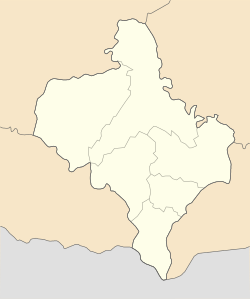Sniatyn
Sniatyn
Снятин Śniatyn | |
|---|---|
 Town hall | |
| Coordinates: 48°27′00″N 25°34′00″E / 48.45000°N 25.56667°E | |
| Country | |
| Oblast | Ivano-Frankivsk Oblast |
| Raion | Kolomyia Raion |
| Hromada | Sniatyn urban hromada |
| First mentioned | 1158 |
| Population (2022) | |
| • Total | 9,718 |
Sniatyn (Ukrainian: Снятин, IPA: [ˈsnʲɑtɪn]; Polish: Śniatyn; Romanian: Sneatîn, older Sniatin; Yiddish: שניאַטין) is a city located in Kolomyia Raion of Ivano-Frankivsk Oblast, in western Ukraine along the Prut river, in the historic region of Pokutia. Sniatyn hosts the administration of Sniatyn urban hromada, one of the hromadas of Ukraine.[1] Population: 9,718 (2022 estimate).[2] In 2001, population was around 10,500.
In the interbellum period, it was a rail border crossing between Poland and Romania.
History
[edit]
The first mention of the town is in 1158. Ksniatyn was named after Kostiantyn Stroslavich, a boyar and general of Yaroslav Osmomysl—a prince of medieval Halych Principality. From 1416 comes the first mention of an Armenian in Śniatyn.[3] The town was given the Magdeburg rights in 1448. In 1628, an Armenian commune was established by King Sigismund III Vasa, one of several such communes in Poland.[4] As a result of the First Partition of Poland, Sniatyn (and Galicia) was attributed to the Habsburg monarchy.[5] In the interwar period, Śniatyn was part of reborn independent Poland, within which it was a county seat in the Stanisławów Voivodeship.
| Year | Pop. | ±% |
|---|---|---|
| 1921 | 10,597 | — |
| 1931 | 10,915 | +3.0% |
| 2022 | 9,718 | −11.0% |
| Source: [6] | ||
In 1939, Śniatyn was the temporary seat of American embassy in Poland, as the diplomatic personnel abandoned Warsaw after the first German Nazi bombings at the start of World War II. In mid-September 1939, the Polish gold reserve was evacuated from Warsaw and stored by the Polish government in Śniatyn, before it was eventually further evacuated via Romania to the territory of Polish-allied France.[7] Afterwards, the town was occupied by the Soviet Union until 1941, then by Germany until 1944, and re-occupied by the Soviet Union, which annexed it from Poland in 1945. Nearly all of Sniatyn's Jewish population was murdered during the Holocaust. Many were shot and buried in the local forest. Some died from disease and starvation in the ghetto. Approximately 1,500 people were sent to Belzec.
Until 18 July 2020, Sniatyn was the administrative center of Sniatyn Raion. The raion was abolished in July 2020 as part of the administrative reform of Ukraine, which reduced the number of raions of Ivano-Frankivsk Oblast to six. The area of Sniatyn Raion was merged into Kolomyia Raion.[8][9]
Gallery
[edit]-
Shevchenko Street
-
Church of Ascension
-
Roman Catholic Church
-
Church of Archangel Michael's Miracle at Colassai
References
[edit]- ^ "Снятынская городская громада" (in Russian). Портал об'єднаних громад України.
- ^ Чисельність наявного населення України на 1 січня 2022 [Number of Present Population of Ukraine, as of January 1, 2022] (PDF) (in Ukrainian and English). Kyiv: State Statistics Service of Ukraine. Archived (PDF) from the original on 4 July 2022.
- ^ Stopka, Krzysztof (2000). Ormianie w Polsce dawnej i dzisiejszej (in Polish). Kraków: Księgarnia Akademicka. p. 117. ISBN 83-7188-325-0.
- ^ Stopka, p. 127
- ^ Atlas des peuples d'Europe centrale, André et Jean Sellier, 1991, p.88
- ^ Wiadomości Statystyczne Głównego Urzędu Statystycznego (in Polish). Vol. X. Warszawa: Główny Urząd Statystyczny. 1932. p. 141.
- ^ Wróbel, Janusz (2002). "Wojenne losy polskiego złota". Biuletyn Instytutu Pamięci Narodowej (in Polish). No. 8–9 (19–20). IPN. pp. 56–57. ISSN 1641-9561.
- ^ "Про утворення та ліквідацію районів. Постанова Верховної Ради України № 807-ІХ". Голос України (in Ukrainian). 2020-07-18. Retrieved 2020-10-03.
- ^ "Нові райони: карти + склад" (in Ukrainian). Міністерство розвитку громад та територій України.








